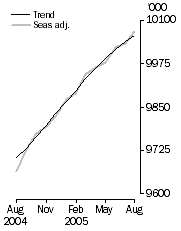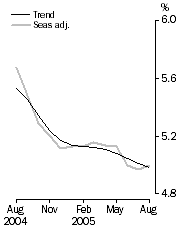AUGUST KEY FIGURES
 |  | Jul 2005 | Aug 2005 | Jul 05 to Aug 05 | Aug 04 to Aug 05 |
|
| Trend |  |  |  |  |  |  |
 | Employed persons ('000) | 10 037.7 | 10 056.4 | 18.7 |  | 3.6 | % |
 | Unemployed persons ('000) | 529.7 | 527.5 | -2.2 |  | -7.1 | % |
 | Unemployment rate (%) | 5.0 | 5.0 | 0.0 | pts | -0.5 | pts |
 | Participation rate (%) | 64.7 | 64.7 | 0.0 | pts | 1.2 | pts |
| Seasonally Adjusted |  |  |  |  |  |  |
 | Employed persons ('000) | 10 034.9 | 10 067.5 | 32.6 |  | 4.2 | % |
 | Unemployed persons ('000) | 524.8 | 529.9 | 5.1 |  | -8.8 | % |
 | Unemployment rate (%) | 5.0 | 5.0 | 0.0 | pts | -0.7 | pts |
 | Participation rate (%) | 64.6 | 64.8 | 0.2 | pts | 1.3 | pts |
|
Employed Persons

| Unemployment rate

|
AUGUST KEY POINTS
TREND ESTIMATES (MONTHLY CHANGE)
- EMPLOYMENT increased to 10,056,400
- UNEMPLOYMENT decreased to 527,500
- UNEMPLOYMENT RATE remained at 5.0%
- PARTICIPATION RATE remained at 64.7%
SEASONALLY ADJUSTED ESTIMATES (MONTHLY CHANGE)
EMPLOYMENT
- increased by 32,600 to 10,067,500. Full-time employment increased by 16,100 to 7,186,300 and part-time employment increased by 16,500 to 2,881,100.
UNEMPLOYMENT
- increased by 5,100 to 529,900. The number of persons looking for full-time work increased by 7,200 to 372,800 while the number of persons looking for part-time work decreased by 2,100 to 157,000.
UNEMPLOYMENT RATE
- remained at 5.0%. The male unemployment rate increased by 0.2 percentage points to 4.9% while the female unemployment rate decreased by 0.2 percentage points to 5.1%.
PARTICIPATION RATE
- increased by 0.2 percentage points to 64.8%.
NOTES
ROUNDING
Estimates of monthly change shown on the front cover have been calculated using unrounded estimates, and may be different from, but are more accurate than, movements obtained from the rounded estimates. The graphs on the front cover also depict unrounded estimates.
SAMPLING ERRORS
The estimates in this publication are based on a sample survey. Because the entire population is not enumerated, the published estimates and the movements derived from them are subject to sampling variability. Standard errors give a measure of this variability and appear on pages 27 and 28.
The 95% confidence intervals below provide another way of looking at the variability inherent in estimates from sample surveys. The interval bounded by the two limits is the 95% confidence interval. A 95% confidence interval has a 95% chance of including the true value of the estimate.
Movements in seasonally adjusted series between July and August 2005 |
|  |
 | Monthly change | 95% Confidence interval |  |
 |  |  |  |  |  |
|  |
| Total Employment | 32 600 | -19 000 | to | 84 200 |  |
| Total Unemployment | 5 100 | -21 900 | to | 32 100 |  |
| Unemployment rate | 0.0 pts | -0.2 pts | to | 0.2 pts |  |
| Participation rate | 0.2 pts | -0.2 pts | to | 0.6 pts |  |
|  |
INQUIRIES
For further information about these and related statistics, contact the National Information and Referral Service on 1300 135 070 or Michael Johnson on Canberra (02) 6252 6525.
INTRODUCTION OF UPDATED STANDARD ERROR ESTIMATES
INTRODUCTION
Estimates from the Labour Force Survey (LFS) are based on information collected from people in a sample of dwellings, rather than all dwellings. Hence the estimates produced may differ from those that would have been produced if the entire population had been included in the survey. The most common measure of the likely difference (or 'sampling error') is the standard error (SE).
Following each Census of Population and Housing, the ABS selects a new sample for the Labour Force Survey. This is done to ensure that the sample continues to accurately represent the distribution of the Australian population. Revised standard error models for the 2001 census based sample have been used for the LFS in August 2005 and apply from November 2002 until the next revision, expected to be released in 2009.
IMPROVEMENTS TO THE STANDARD ERROR MODELS
In previous updates, a single standard error model was prepared for original level estimates, and another for original monthly movement estimates.
To improve the accuracy of the models, separate models have been created for estimates of employed, unemployed and persons not in the labour force, cross classified by sex, age, marital status, state, territory, capital city and balance of state. Standard error models have been developed separately for each labour force status, in each state, territory, and Australia. A single model for standard errors of all labour force status types proved sufficient for LFS regions.
In the new standard error tables, some standard errors for large estimates are higher than perviously published. This is not due to the standard errors of the new sample being higher than those for the previous sample; rather it reflects the improved accuracy obtained from the latest models in the estimation of standard errors, which is particularly evident for large estimates.
STANDARD ERROR TABLES
Each individual Labour Force Survey estimate has its own standard error. However, space limitations make it impractical to print the standard error of each estimate in this publication. Instead, tables of standard errors have been provided on pages 27 and 28 of this publication to enable readers to approximate the standard error for an estimate. These tables include standard error estimates from the improved models.
Note that these standard errors apply to original estimates. They are not applicable to seasonally adjusted or trend estimates, although a reasonable approximation can be made for the standard errors of seasonally adjusted (but not trend) estimates using the standard errors for original estimates.
FURTHER INFORMATION
A spreadsheet that incorporates the standard error model has been developed to allow users to quickly calculate standard errors and RSEs for specific estimates. For further information, see Labour Force Survey Standard Errors, 2005 (cat.no.6298.0) and Labour Force Survey Standard Errors, Spreadsheet (cat.no.6298.0.55.001). Both products are available free on the ABS website <https://www.abs.gov.au>. Alternatively, contact Craig Blair, Assistant Director of Labour Household Surveys on Canberra (02) 6252 5967, or email <craig.blair@abs.gov.au>.
PRINCIPAL LABOUR FORCE SERIES TREND ESTIMATES
EMPLOYED PERSONS
The trend estimate of employed persons generally rose from 8,293,600 in August 1995 to 9,056,100 in September 2000. The trend then fell slightly to 9,034,600 in January 2001, before rising to 9,457,000 in March 2003. The trend estimate then fell for two months, before rising to stand at 10,056,400 in August 2005.
UNEMPLOYED PERSONS
The trend estimate of unemployed persons rose from 730,400 in August 1995 to 771,800 in February 1997. The trend then fell to 583,300 in September 2000, before rising to 685,500 in October 2001. The trend has since generally fallen to stand at 527,500 in August 2005.
UNEMPLOYMENT RATE
The trend unemployment rate rose slowly from 8.1% in August 1995 to 8.4% in February 1997. After falling to 6.1% in September 2000, the trend then rose to 7.0% in October 2001. The trend has since generally fallen to stand at 5.0% in August 2005.
PARTICIPATION RATE TREND SERIES
MALES
The trend estimate of the male participation rate generally fell from 73.9% in August 1995 to 71.4% in July 2003. The trend then rose to 71.8% in March 2004 before falling to 71.5% in September 2004. The trend has since risen steadily to stand at 72.4% in August 2005.
FEMALES
Although fluctuating, the trend estimate of the female participation rate fell slightly from 53.9% in August 1995 to 53.5% in May 1999, before rising to 55.4% in June 2001. The trend estimate then fell to 54.9% in April 2002 and rose again to 56.3% in February 2003. After falling to 55.5% in January 2004, the trend then rose to stand at 57.4% in August 2005.
PERSONS
The trend estimate of the participation rate fell from 63.7% in August 1995 to 62.8% in May 1999. Although fluctuating, the trend then rose to 63.9% in February 2003 before falling to 63.4% in September 2003. The trend estimate has since risen steadily to stand at 64.7% in August 2005.
 Print Page
Print Page
 Print All
Print All